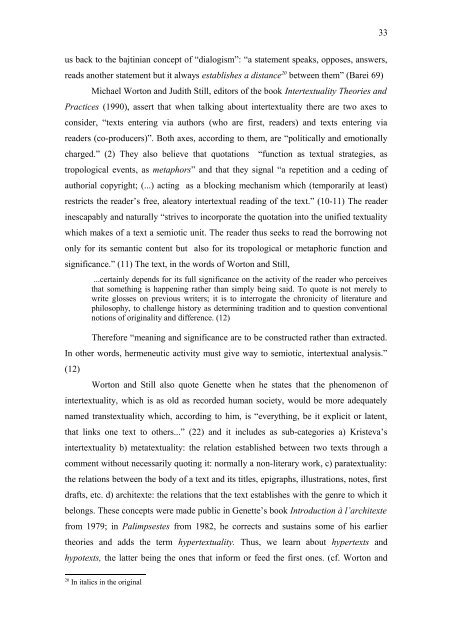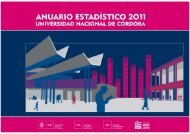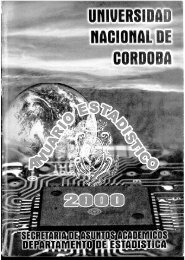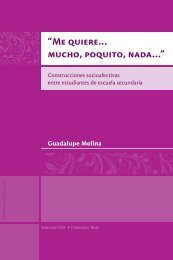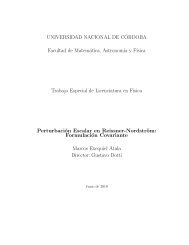Chapter I - RDU - Universidad Nacional de Córdoba
Chapter I - RDU - Universidad Nacional de Córdoba
Chapter I - RDU - Universidad Nacional de Córdoba
You also want an ePaper? Increase the reach of your titles
YUMPU automatically turns print PDFs into web optimized ePapers that Google loves.
33us back to the bajtinian concept of “dialogism”: “a statement speaks, opposes, answers,reads another statement but it always establishes a distance 20 between them” (Barei 69)Michael Worton and Judith Still, editors of the book Intertextuality Theories andPractices (1990), assert that when talking about intertextuality there are two axes toconsi<strong>de</strong>r, “texts entering via authors (who are first, rea<strong>de</strong>rs) and texts entering viarea<strong>de</strong>rs (co-producers)”. Both axes, according to them, are “politically and emotionallycharged.” (2) They also believe that quotations “function as textual strategies, astropological events, as metaphors” and that they signal “a repetition and a ceding ofauthorial copyright; (...) acting as a blocking mechanism which (temporarily at least)restricts the rea<strong>de</strong>r’s free, aleatory intertextual reading of the text.” (10-11) The rea<strong>de</strong>rinescapably and naturally “strives to incorporate the quotation into the unified textualitywhich makes of a text a semiotic unit. The rea<strong>de</strong>r thus seeks to read the borrowing notonly for its semantic content but also for its tropological or metaphoric function andsignificance.” (11) The text, in the words of Worton and Still,...certainly <strong>de</strong>pends for its full significance on the activity of the rea<strong>de</strong>r who perceivesthat something is happening rather than simply being said. To quote is not merely towrite glosses on previous writers; it is to interrogate the chronicity of literature andphilosophy, to challenge history as <strong>de</strong>termining tradition and to question conventionalnotions of originality and difference. (12)Therefore “meaning and significance are to be constructed rather than extracted.In other words, hermeneutic activity must give way to semiotic, intertextual analysis.”(12)Worton and Still also quote Genette when he states that the phenomenon ofintertextuality, which is as old as recor<strong>de</strong>d human society, would be more a<strong>de</strong>quatelynamed transtextuality which, according to him, is “everything, be it explicit or latent,that links one text to others...” (22) and it inclu<strong>de</strong>s as sub-categories a) Kristeva’sintertextuality b) metatextuality: the relation established between two texts through acomment without necessarily quoting it: normally a non-literary work, c) paratextuality:the relations between the body of a text and its titles, epigraphs, illustrations, notes, firstdrafts, etc. d) architexte: the relations that the text establishes with the genre to which itbelongs. These concepts were ma<strong>de</strong> public in Genette’s book Introduction à l’architextefrom 1979; in Palimpsestes from 1982, he corrects and sustains some of his earliertheories and adds the term hypertextuality. Thus, we learn about hypertexts andhypotexts, the latter being the ones that inform or feed the first ones. (cf. Worton and20In italics in the original


